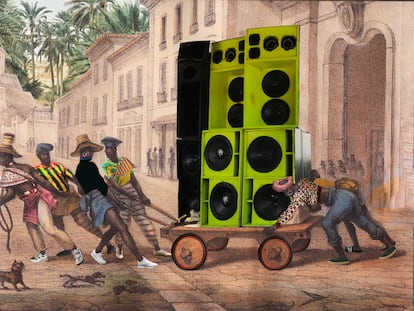Brazilian artist Rosana Paulino heals the wounds of slavery
An exhibition at the Buenos Aires Museum of Latin American Art showcases 80 works by the first Black artist to have a solo exhibition there
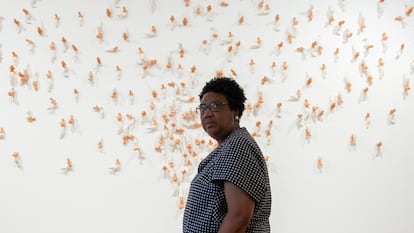
Brazilian artist Rosana Paulino first searched for the black faces of her ancestors in family albums. She then enlarged and printed them on fabric, sewing the pieces together with visible stitches as her mother had taught her. These creations, known as patuás, are small pouches filled with seeds, prayers and other objects believed to offer protection according to the tradition of Candomblé, an Afro-Brazilian religion. Thirty years ago, Paulino assembled 1,500 of these amulets into a mural that marked her arrival on the Brazilian art scene and the beginning of her main artistic theme – the legacy of slavery and reestablishing emotional ties among the millions taken from Africa to America over centuries.
Paulino’s ongoing exploration through art is showcased in an exhibition that runs from March 29 to June 10 at the Buenos Aires Museum of Latin American Art (MALBA), in the museum’s first exhibition solely devoted to a Black artist. Standing in front of Parede da memoria (Wall of Memories, in English), the large mural she created in 1994, Paulino uses few words to describe it because she’d rather people come and see it for themselves. She explains that the images are of 11 ancestors, but did not include any of herself since her genes are already represented there. Paulino also says that the work speaks “of the strength of the community... It’s not just my own history — it belongs to my family and all Black people. I mean, you can ignore one person, but when you’ve got 1,500 pairs of eyes on you... you can’t ignore that.” This piece, which Paulino views as her first work, is displayed alongside more recent creations like a triptych, and a series of paintings depicting women with bromeliads in their mouths and feet like mangrove roots.
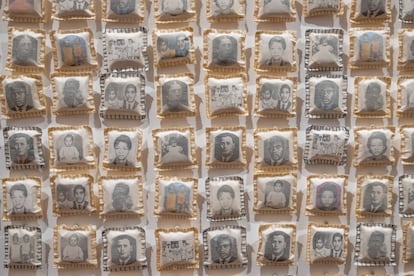
Since she first created that mural 30 years ago, Paulino, a 57-year-old artist born on the outskirts of São Paulo, has been developing her art and earned a doctorate in visual arts along the way. MALBA curators Andrea Giunta and Igor Simões selected 80 of her pieces for the exhibition they called “Amefricana,” in reference to the concept of Afro-American fusion coined by Brazilian philosopher Lélia Gonzáles. Four pieces are from MALBA’s private collection. The exhibition showcases Paulino’s engravings, embroidery, installations, drawings, sculptures and one video. Paulino’s 2016 book, ¿História natural? (Natural History?), explores concepts of human progress and science through images printed on paper and fabric. Lately, she has started delving into using new technologies in her art.
The path through the exhibition is not chronological nor is it arranged thematically. Rather, it focuses on Paulino’s interpretation of the Black presence in Brazil and the rest of America. Paulino uses personal and historical archives in her art, some of which were destroyed after Brazil’s abolition of slavery in 1888. The exhibition curators believe this collection sheds light on Paulino’s work and her scrutiny of the role of Black women in colonial structures, as well as contemporary exclusion mechanisms.
Some of Paulino’s pieces use images captured by photographer August Stahl in the 19th century. Stahl was commissioned by scientist Louis Agassis to illustrate his theories on human hierarchies. These photos enabled Paulino to delve into “how science was used to justify slavery.” Pieces like Assentamento (2013) (Settlement) depict stark images of naked Black women that have been cut horizontally and imperfectly pasted back together. “Those cuts — that’s where the trauma is. This is the trauma of Brazil and Black people. These people had to reinvent themselves or die,” said Paulino. You can hear the sound of the sea in that room, much like the people shackled in the holds of slave ships. On the floor, piles of human arms are stacked on kindling, ready to light into bonfires.
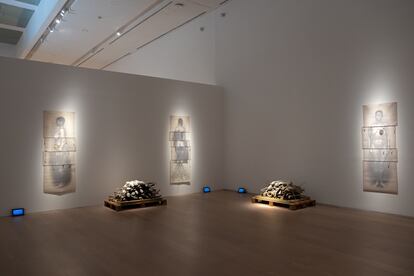
Paulino uses historical photos and resources like ribbons, synthetic hair and Portuguese tiles to explore “the subjectivity of Black women.” For instance, in an untitled 2006 piece, she encapsulated fragments of hair from Black women in microscope lenses, naming them Dora, Regina, Teresa... Another example is the 2007 piece Ama de leite (Wet Nurse), which depicts silhouettes of Black women caring for white children. Streams of milk flow from their breasts into baby bottles with photos of the wet nurses inside. “If you want to see the faces in the bottles, you have to bend down because they’re pretty low. It’s like bowing to show respect and acknowledge that these women were real people,” said Paulino, who crouched and pointed to one of the bottles.
“A turning point in the history of Brazilian art”
MALBA curator Igor Simões is a specialist in the African diaspora who believes that Paulino “represents a turning point in the history of Brazilian art... Today, the increased presence of Black artists, curators and researchers in Brazil is credited to Rosana Paulino’s groundbreaking work.” Over half of Brazil’s population is Black or of mixed race. To make a statement, Paulino created a flag to fly over MALBA, much like she did for an earlier exhibition at the Rio Museum of Art. The flag is blue and red, and bears the profile of a Black woman with plant leaves coming out of her open mouth. At the bottom, an inscription reads Pretuguês, a word that refers to Black appropriation of the Portuguese language.
Simões emphasizes the importance of Paulino’s drawings as they form the foundation of her ideas and demonstrate the evolution of her work. “It’s crucial to showcase the thought processes of Black artists. For a long time, the work of Black artists has been seen as purely spontaneous,” he said. To illustrate his point, Simões points to a series of graphite and watercolor drawings of insects in different stages of metamorphosis.
In an installation in the same room, the insect drawings become three-dimensional in Telcelãs (2003). Clay and thread sculptures — half-woman and half-insect — populate the piece. The figures hang twisted from the wall, undergoing metamorphosis. Below on the floor, they have shed their cocoons. “[The figures] are escaping their cocoons — the colonial shackles of slavery in Brazil,” wrote Kanitra Fletcher in an essay on Paulino’s work. “They represent resistance and hope. I’m very interested in transformation,” said Paulino, who learned to mold clay with her mother and sister at home. She says little else other than, “They represent very personal feelings, but also a community. That’s what I want people to think about when they see them.”
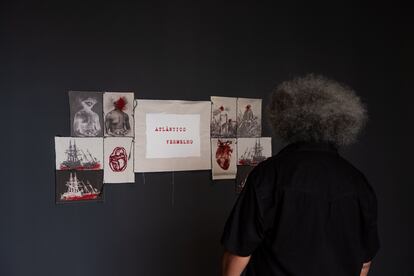
Sign up for our weekly newsletter to get more English-language news coverage from EL PAÍS USA Edition
Tu suscripción se está usando en otro dispositivo
¿Quieres añadir otro usuario a tu suscripción?
Si continúas leyendo en este dispositivo, no se podrá leer en el otro.
FlechaTu suscripción se está usando en otro dispositivo y solo puedes acceder a EL PAÍS desde un dispositivo a la vez.
Si quieres compartir tu cuenta, cambia tu suscripción a la modalidad Premium, así podrás añadir otro usuario. Cada uno accederá con su propia cuenta de email, lo que os permitirá personalizar vuestra experiencia en EL PAÍS.
¿Tienes una suscripción de empresa? Accede aquí para contratar más cuentas.
En el caso de no saber quién está usando tu cuenta, te recomendamos cambiar tu contraseña aquí.
Si decides continuar compartiendo tu cuenta, este mensaje se mostrará en tu dispositivo y en el de la otra persona que está usando tu cuenta de forma indefinida, afectando a tu experiencia de lectura. Puedes consultar aquí los términos y condiciones de la suscripción digital.
More information
Archived In
Últimas noticias
Maduro pleads not guilty before the federal court in New York: ‘I am still the president of Venezuela’
A new test can detect Alzheimer’s from a finger prick
UN team enters Sudanese city of El Fasher after paramilitary massacre: ‘It’s like a ghost town’
A recipe for resistance: Indigenous peoples politicize their struggles from the kitchen
Most viewed
- Gilles Lipovetsky: ‘If you want to live better and fall in love, take Prozac, don’t look to philosophy’
- Alain Aspect, Nobel laureate in physics: ‘Einstein was so smart that he would have had to recognize quantum entanglement’
- Alvin Hellerstein, a 92-year-old judge appointed by Bill Clinton, to preside over Maduro’s trial in New York
- Why oil has been at the center of Venezuela-US conflicts for decades
- Maduro’s downfall puts China’s relationship with Venezuela to the test
